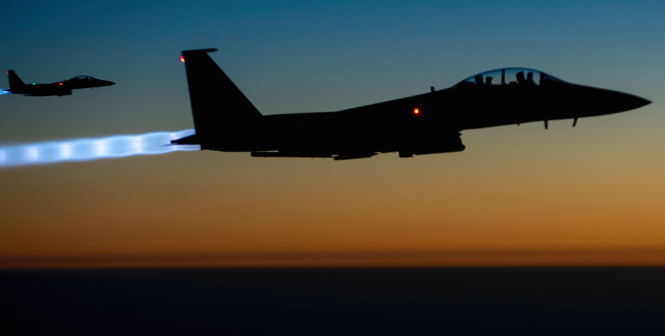Is Turkey Undermining the US Led War Effort Against IS?

Turkey’s decision to join the United States led war against IS will bring collateral damage that will further complicate the war effort.
For many Middle East strategic analysts, Turkey’s decision to join the fight against Islamic State is long overdue. The Ankara government had resisted moves to join the coalition, arguing the war should not be limited to just IS, but should also include a focus of taking down the Bashar al-Assad regime in Syria. This intransigence sparked a backlash, with many arguing that Turkey supported terrorism and should be kicked out of NATO.
But the 20th July suicide bombing in the Turkish town of Suruc by a Turkish citizen with links to IS, which resulted in the death of 32 people, altered the strategic sails of the Ankara government. In response to these attacks, Turkey announced that the United States and other allies could use the Turkish Incirlik and Diyarbakir airbase to carry out bombing operations against IS targets in Syria. This change in posture also saw Turkey begin, for the first time, a bombing offensive against a number of IS sites in Syria.
While this is seen as a significant gain for the Obama administration, this shift in Turkey’s strategic outlook will complicate the United States war against IS, and will increase the likelihood that the United States will find itself embroiled in a bloody battle with Bashar al-Assad.
This latest agreement between the United States and Turkey includes a “safe zone” in Northern Syria. This 100km IS free zone within Syria is designed to provide the environment where coalition airstrikes can eradicate IS forces, and accommodate the space for moderate Syrian rebels to withstand the IS threat.
However this safe zone is more about Turkey than the United States. For Turkey, the agreement places equal importance on clearing out Kurdish fighters as it does on IS. The safe zone is currently made up of ethnic Turkmen and Arabs, and any move by the Kurds to agitate this amalgamation is seen as a ‘red line’ by Ankara, which could trigger a military response.
The trouble here is Turkey has become increasingly anxious about the territorial gains the Kurdish forces have made against IS in Syria. Since the civil war in Syria began four years ago, the Kurds have established more territorial control than ever before, and are on track to maintain authority over the vast majority of Syria’s northern border. By wedging an IS safe zone in the midst of this region, Turkey is essentially blockading the Kurds’ ability to have unfettered control, and eventual autonomy, on Turkey’s southern border.
This has consequences for the United States war against IS. The Kurds have been the most effective ground force in countering IS in Syria. But by constraining the Kurdish forces to the eastern side of the safe zone, the United States will need to find alternative forces to fight IS in northwestern Syria.
The safe zone also has the potential to escalate into a full-blown war against Syria’s al-Assad forces. While Assad’s military has not used its air defence system against US strikes in Syria, the temptation for Syrian forces to target opposition groups in this zone cannot be dismissed. If this were to occur, the United States may be forced to retaliate, finding themselves in a battle with pro-Assad forces, that they have long tried to avoid.
This latest agreement between the United States and Turkey also comes with the added burden of Turkey targeting both PKK and YPG positions in Iraq and Syria. This “two-pronged approach”, which essentially links IS and the Kurdish forces as one and the same, has seen Turkey prioritise Kurdish targets, over that of IS. Between 24 – 26th July, the Turkish air force dispatched 75 F-16s and F-4 Vietnam war era Phantom fighter bombers in three surges, offloading 300 guided bombs in 185 sorties against approximately 400 PKK targets. This compares with just a single sortie against IS forces, on the 23rd July, stationed close to the Turkey border.
This disproportionate approach has raised questions about Turkey’s intentions and underlying motives in the war against IS. Many have argued that domestic politics are at the heart of this reversal in strategic direction, and President Erdogan is looking to buttress the anti-Kurdish sentiment amongst nationalist Turks, with a view to the elections that could be held as early as November this year. President Erdogan and his ruling AKP Party lost their overall majority in the June 7th elections. With the forming of a coalition government looking increasingly unlikely, it is argued that by linking the PKK with IS, Erdogan will disenfranchise the pro-Kurdish People’s Democratic Party (HDP) vote – which took 13% of the votes in the recent election – and agitate enough support within the nationalist ranks to once again deliver an overall majority.
The culmination of these factors has led many commentators to argue that the United States has knowingly – or unwittingly – ceded to a deal with Turkey that does little to support its strategic interests. While this could be shown to be wrong, and this strategic about-face by Turkey in the fight against IS might well turn out to be a positive development, this will not be without its immediate challenges.
Anthony Ricketts is a PhD student at the School of Political Science and International Studies at the University of Queensland. His research focuses on the Geo-Politics of the Middle East. He can be contacted by email on anthony.ricketts@me.com and followed on twitter @AnthonyRicketts. This article can be republished with attribution under a Creative Commons Licence.





